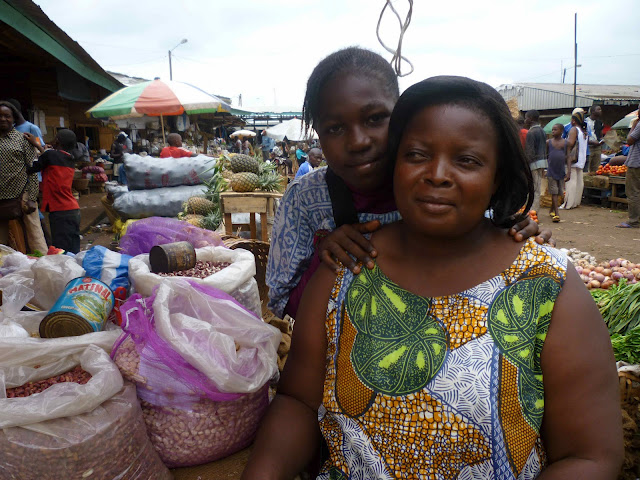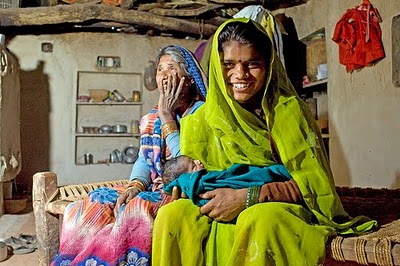-
‘NSB’ Blogs from the 2010 Global Maternal Health Conference in New Delhi
›The 2010 Global Maternal Health Conference kicked off today, perhaps fittingly, in India – one of the world’s fastest growing nations but one that also faces serious reproductive health challenges. The Wilson Center’s Calyn Ostrowski is in New Delhi for the conference and will be providing updates to The New Security Beat throughout the week.
Those interested can also find a schedule of events and list of participants on the conference website as well as live webcasted events on the main page. Stay tuned!
Photo Credit: “Mumbai, India, November 2009” courtesy of flickr user travelmeasia. -
How Maternal Mortality and Morbidity Impact Economic Development
›“Investing in women and girls is the right thing to do,” says Mayra Buvinic, sector director of the World Bank’s gender and development group. “It is not only fair for gender equality, but it is smart economics.” But while it may be smart economics, many developing countries fail to address the underlying social causes that impact economic growth, such as poverty and gender inequality. Buvinic was joined by Dr. Nomonde Xundu, health attaché at the Embassy of South Africa in Washington, D.C., and Mary Ellen Stanton, senior maternal health advisor at the U.S. Agency for International Development (USAID), at the sixth meeting of the Advancing Policy Dialogue on Maternal Health Series, which addressed the economic impact of maternal mortality and provided evidence for the need for increased investment in maternal health.
-
Women Deliver in the Climate Change Debate
›One of the hottest topics at the “Women Deliver” conference earlier this month—where panels ran the gamut from HIV prevention and family planning to gender-based violence and maternal health—was the intersection of women’s reproductive health, global population growth, and climate change.
As panelists at three of the conference’s climate-focused events noted, women in poor, rural areas are especially vulnerable to the impacts of climate change. In many developing countries across Africa, Asia, and Latin America, women take on much of the burden of farming, gathering fuel, and supplying fresh water for their communities. As a result, they bear the brunt of hardships when climate change alters seasonal precipitation patterns, or increases scarcity of key natural resources.
In addition, “the more assets, the less vulnerable one person is,” said Lorena Aguilar of the International Union for Conservation of Nature. “Worldwide, compared to men, women tend to have more limited access to resources that would enhance their capacity to adapt to climate change—including land, credit, agricultural inputs, decision-making bodies, technology, and training services.”
Women’s hardship in the face of climate change can also have a negative effect on reproductive health. Aguilar remarked that during the dry season in parts of rural India and Africa, 30 percent or more of women’s daily caloric intake is spent on fetching water alone. The enormous physical strain placed on women’s bodies because of those tasks has resulted in higher miscarriage rates among those populations, she noted.
Educating Girls to Protect the Environment
Organizations like the United Nations and the Global Gender and Climate Alliance have been working in recent years to bridge the gap between women’s rights and climate change, and reframe climate change in terms of human development. But to date, women’s struggles with climate change have not translated into meaningful economic, educational, or healthcare support at the local government level, with women’s welfare “at the very bottom of the priority list” for most developing countries, according to Nickie Imanguli with Advocates for Youth.
The unmet need for family planning tools and services is perhaps the movement’s principal challenge going forward. With an estimated 200 million women having an unmet need for family planning, unintended pregnancies could be exacerbating environmental problems such as depletion of forests, water, and other finite resources. But most panelists expressed optimism that the growing recognition of a connection between climate change and women’s reproductive health might lead to a boost in funding for family planning initiatives in underserved areas of the world.
Speakers at Women Deliver emphasized that reproductive health can be bolstered by improving educational opportunities for girls in poor rural areas. Joy Nayiga with Uganda’s Ministry of Finance Planning Economic Development noted that “girls are more likely than boys to drop out of school to help their mothers gather fuel, wood, and water.” This trend, she said, robs females of an opportunity for educational advancement, and heightens the likelihood they will end up starting families of their own while very young.
Nayiga and other panelists asserted that empowering females through education leads them to take greater control over their own sexual health, making it easier for them to start their families later in life, or perhaps have a smaller number of children.
Encouraging women to take a more active role in family planning in this regard serves as “a win-win situation for women, their communities, and the nations of the world,” by “bending down the overall trajectory of population growth,” asserted the Worldwatch Institute’s Robert Engelman.
Some speakers also argued that enabling women to delay motherhood if they want could yield direct environmental benefits for nations of the Global South that are struggling to adapt to climate change. Since women are often responsible for overseeing agriculture and forest resource management practices in their communities, they help create localized carbon sinks across the developing world.
“Women pull carbon out of the atmosphere and bury it, in farm soils, in trees that they grow,” noted the Worldwatch Institute’s Engelman, who even suggested women’s aggregate impact removing carbon could be more effective than cap-and-trade plans.
Moving Slowly From Talk to Action
Given both their vulnerability to the effects of climate change—and their potential to help offset those same impacts—“women are critical stakeholders in climate change moving forward,” said Population Action International’s Kathleen Mogelgaard. So far, however, while there may be growing discussion about giving women a more prominent seat at the table when developing climate change adaptation and mitigation plans, that has not yet happened.
“We’re not seeing big government investment in empowering women on the issue of climate change,” remarked Leo Bryant, with Marie Stopes International, a U.K.-based NGO specializing in sexual and reproductive health. Instead, Bryant said, it has been NGOs that have been doing much of the heavy lifting of bringing women into the conversation.
But many panelists felt that, in time, governments will recognize it is in their enlightened self-interest to link issues of gender rights and climate change. “By upholding women’s rights,” concluded the IUCN’s Lorena Aguilar, “we are in fact making one of the most crucial preparations associated to climate change that any society can make.”
Click here for additional New Security Beat coverage of reproductive health talks at the Women Deliver conference, or here for more coverage of the interplay between traditional gender roles and family planning.
Sources: International Institute for Sustainable Development, International Union for the Conservation of Nature, Marie Stopes International, Population Action International, Population Reference Bureau, The Times (U.K.), United Nations Development Programme, Women Deliver, Worldwatch Institute.
Photo Credit: “Climate Change Canvas” courtesy of Amnesty International. -
Women Deliver: Real Solutions for Reproductive Health and Maternal Mortality
›The landmark Women Deliver conference, which concluded last week, reinvigorated the global health community’s commitment to improve reproductive health at both the grassroots and global levels. Providing a major boost was the Gates Foundation’s announcement that it will commit an additional $1.5 billion over the next five years to support maternal and child health, family planning, and nutrition programs in developing countries.
“We haven’t tried hard enough,” said Gates Foundation co-founder Melinda Gates. “Most maternal and newborn deaths can be prevented with existing, low-cost solutions.” Examples of these efficient and effective solutions were presented at the three-day conference’s dozens of panels on a wide range of issues, including climate change, contraceptive commodities, fistula, gender inequities, adolescent family planning, communications and technology, and much more.
Empowering Young Girls to Access Family Planning
“When we speak about adolescents we typically think of prevention. However, we must also think about providing access to safe abortions and supporting young women who want to be mothers and empower young women to make choices,” said Katie Chau, a consultant at International Planned Parenthood Federation.
In Nigeria, “there is not much attention on adolescent sexual and reproductive health, even though a majority of rapes occur before the age of 13, and the rate of teenage pregnancy and abortions is high,” said Bene Madunagu, chair of the Girls’ Power Initiative (GPI) in Nigeria. GPI teaches girls about their rights to make decisions, including those regarding sex and reproductive health, as well as improving their critical thinking skills, self-esteem, and body image. “Girls develop critical consciousness and question discriminatory practices, while also learning about the legal instruments to take up their concerns,” he said.
Sadaf Nasim of Rahnuma Family Planning said child marriages are common in his country, Pakistan. “Marriage is an easy solution for poor families. Once a girl is married she is no longer the responsibility of the family,” he explained.
While laws in Pakistan and other parts of the developing world condemn child marriage, the prevalence of child marriage remains high: 49 percent of girls are married by age 18 in South Asia, and 44 percent in West and Central Africa. Nasim said birth registration at the local and national levels should be improved to prevent parents from manipulating their daughter’s age.
In Kyrgyzstan, “community-based efforts worked to galvanize media attention and disseminate information to demonstrate the need for improved adolescent family planning,” said Tatiana Popovitskaya, a project coordinator with Reproductive Health Alliance of Kyrgyzstan. Such community-based approaches use grassroots education to mobilize community leaders, which is a critical step in overcoming child marriage and other harmful traditions.
Cell Phones and Maternal Health
“There is a lot of information being collected, but it is not necessarily going where it needs to because of fragmentation,” said Alison Bloch, program director at mHealth Alliance. In developing countries, the people most in need are often the most isolated, but mobile technology is emerging as a way to bridge the gaps.
According to a recent report by mHealth Alliance, 64 percent of mobile phone users live in developing countries and more than half of people living in remote areas will have mobile phones by 2012. The potential for improving global health with cell phones and PDAs is significant, and can address a wide range of health issues, such as human resource shortages and information sharing problems between clinics and hospitals.
“Mobile technology provides benefits to individuals, institutions, caregivers, and the community. It reduces travel time and costs for the individual, improves efficiency of health service delivery, and streamlines information to health workers to reduce maternal mortality,” said Elaine Weidman, vice president of sustainability and corporate responsibility at Ericsson.
“Mobile technology is the most rapidly adopted technology in history and represents an existing opportunity to reach the un-reached,” said Fabiano Teixeira da Cruz, a program manager for the Inter-American Development Bank, speaking of the benefits of using mobile technology to train field-based healthcare workers in Latin America.
While mobile phones are indeed reaching parts of the world not currently equipped with quality healthcare, the lack of systematic coordination and infrastructure at the district and regional levels must also be addressed, as highlighted during a recent Wilson Center event, Improving Transportation and Referral for Maternal Health.
Read about our first impressions of Women Deliver 2010 here.
Calyn Ostrowski is program associate with the Wilson Center’s Global Health Initiative
Photo credit: Woman and child in South African AIDS clinic, courtesy Flickr user tcd123usa. -
Women Deliver 2010: First Impressions
›Delivering Solutions for Girls and Women
“We know how to intervene; there does not need to be a magical solution,” said Søren Pind, Denmark’s minister for development cooperation, at the June 7 opening ceremony of Women Deliver 2010.
In its second year, the conference has gathered delegates from 146 countries representing hundreds of non-governmental organizations (NGOs), governments, and civil society organizations under the theme “Delivering Solutions for Girls and Women.” Delegates are working to share projects, policies, successes, and innovations in the field of maternal health and to develop strategies to meet Millennium Development Goal 5.
“Recent trends show great progress and this is very encouraging,” said Gamal Serour, president of the International Federation of Gynecology and Obstetrics (FIGO), speaking of a recent study by the Institute of Health Metrics and Evaluation (IHME). The study found that annual maternal mortality has dropped 34 percent–from 526,000 to 342,900–between 1980 and 2008. Nevertheless, Serour maintained that “we are far away from our goal for 2015.”
Overcoming Tradition and Religious Barriers
Investing in women’s health is not only the right thing to do, it is also economically advantageous. When women are healthy, they provide tremendous benefits to their families, communities, and countries. Women contribute to a majority of the small businesses and agricultural activities of developing countries and their unpaid work at home accounts for almost 33 percent of the world’s GDP. Unfortunately, over 215 million of these women do not have access to family planning services, resulting in unwanted pregnancies, childbirth, and maternal deaths.
There are many barriers to family planning in developing countries, not the least of which are cultural and social traditions that can uphold negative gender-based norms. Tailoring campaigns to address these gender inequities was the subject of discussion at the “Cultural Agents of Change Delivering for Women” session, where panelists acknowledged that collaboration and partnership with a wide-range of actors–from members of the local legislature to civil society organizations and actors in the health sector–are necessary to facilitate change.
Graciela Enciso of the Centro de Investigaciones y Estudios Superiores en Antropología Social-Sureste in Mexico, added that advocacy campaigns to increase support for family planning should be “linked with research.” In many traditional societies, strict interpretations of religion are used to control and disempower women; donors and NGOs “need to think outside the religious box at every point,” said Mary E. Hunt, co-director at the Women’s Alliance for Theology, Ethics, and Ritual.
Male Contraception, Gender Roles, and Family Planning
“I think it is important not to hide behind our cultures and religion,” said Ngozi Okonjo-Iweala, managing director of the World Bank. “We need to work with men and work together to overcome gender inequality.” “Male participation” has been a key theme echoed throughout Women Deliver and is often highlighted as a strategy for reducing maternal mortality.
At the “Men Deliver: Men’s Role in Family Planning” breakout session, experts addressed how new and existing technologies in male contraception and shifting gender roles can help to scale up family planning interventions. “Reducing unwanted pregnancies can also be carried out through male contraception,” said John Townsend, vice president of the reproductive health program at the Population Council.
Condoms are traditionally the main method of contraception for men, but usage rates quickly fall over time and to wear a condom “becomes the women’s responsibility,” said Townsend. To address issues around condom usage, development of alternative family planning technologies, such as gels and implants, is underway. As these technologies are being developed, however, it is important for program managers and donors to consider existing gender norms and the willingness of men to utilize new methods.
In researching gender roles in family planning in Zambia, Holo Hochanda, the chief technical administrator of the Planned Parenthood Association of Zambia, determined that there are many entry points for male intervention and increased family planning. “Men are clients, policymakers, and service providers. Each of these roles provides an opportunity to discuss utilization of male contraception and gender inequities in family planning,” he said. “Men can be key mobilizers and agents for change.”
For more coverage on Women Deliver 2010 click here and to learn more about the Wilson Center’s Maternal Health Dialogue Series visit the Global Health Initiative’s website here. -
Improving Transportation and Referral for Maternal Health
›“Referral has been called an orphan cause,” said Patricia Bailey, public health specialist for Family Health International and Columbia University, because it is “everybody’s responsibility and therefore nobody’s responsibility.”
As part of the Maternal Health Dialogue Series the Woodrow Wilson International Center for Scholars’ Global Health Initiative convened a small technical meeting on May 19, 2010, with 25 experts from five countries to discuss their experiences and share lessons, challenges, and recommendations for improving transportation and referral for maternal health. Following the technical meeting, a public dialogue was held on May 20, 2010, to share the knowledge gaps and recommendations identified. The formal report from the technical meeting will be available in the near future.
Mobilizing District Communities in Rural Ghana
To improve maternal health care in Ghana, “we needed to shift [services] to the community level, where 70 percent of our population lives,” said Dr. John Koku Awoonor-Williams, the east regional director of Ghana Health Service. The “Community-based Health Planning and Services” (CHPS) program was created to galvanize local leadership and empower communities to engage in health outreach activities.
Through this approach, “community health officers and nurses are trained and delegated to distant village locations called CH[I]P zones, in which they are responsible for health education, treatment of minor illnesses, maternal and antenatal care, and referral to district hospitals for emergency care,” said Awoonor-Williams. Community health officers use two-way Motorola walkie-talkies to communicate with traditional birth attendants and referral centers. Pregnant women are given the phone numbers so they can call in the event of complications.
1-0-8 Emergency Number for Improving Maternal Health in India
Many parts of the developing world do not have a 911-style emergency response service. To address this gap, the GVK Emergency Management & Research Institute in India developed the toll-free 1-0-8 telephone number for all medical, police, and fire emergencies.
“We assure every citizen that wherever you are, [if] you call us we will be there,” said Subodh Satyawadi, chief operating officer of GVK. In order to reach the 433 million people covered by GVK, they have:
“Although we address all kinds of emergencies, we heavily focus on maternal health…31 percent of emergencies are pregnancy-related,” said Satyawadi, who said that GVK’s emergency response system has helped save more than 200,000 mothers. Institutional deliveries have increased in the state of Gujarat by 92 percent. “We have been able to reduce maternal mortality by 20-25 percent in different geographies,” he said.- 19,623 EMTs and 10,000 doctors and other healthcare professionals
- 2,710 ambulances
- 16,300 call-center employees
Pre-Hospital Barriers: Reducing Maternal Morbidity in Bolivia
Women in Bolivia receive free maternal care. In cities like La Paz, emergency obstetric care is often available within a short distance. However, “37 percent of our maternal deaths [occur] at our hospitals,” said Víctor Conde Altamirano, OB/GYN of CARE Bolivia.
To better understand this mortality rate, Altamirano evaluated whether pre-hospital barriers and routine antenatal care are associated with near-miss morbidity. He found that women who are older, have lower levels of education, lack antenatal care, are pregnant for the first time, or live in rural areas are at a greatest risk of illness or death
“We are trying to organize our communities and service facilities, and promote improved health management by the municipalities. If our authorities can be sensitive and invest in health; invest in fuel, drugs, and human resources; we can improve near-miss morbidity rates,” said Altamirano.
Strategies and Recommendations for Improving Transportation & Referral
The workshop participants agreed on six key topic areas for improving transportation and referral:1. Multi-sectoral collaboration
The group called for improved multi-sectoral engagement and continuous dialogue among key ministries: Health, Finance, Communication, Social Welfare, Security and Defense, Transportation, and Public Works.
2. Mobile phone technology
3. Public-private partnerships
4. Referral for newborns
5. Indicators for referral
6. Sharing evidence
Private-public partnerships, such as those demonstrated by GVK in India and the CH[I]P program in Ghana, create opportunities for collaboration. “Cell-phone technology can reduce delays in transport and treatment by identifying which facilities might be the most appropriate for referral,” said Bailey.
The final recommendation by the group calls for increased pooling and use of existing evidence to move the transportation and referral agenda forward. Updated synthesis papers on existing evidence are needed, said Bailey. “We have a lot of data that is perhaps less than perfect, but this should not be a barrier for further action,” she said. -
VIDEO: Family Planning in Conflict Areas
›“Displaced people are like every other human being, they want, they need the advantage of family planning. They are asking only for services to be available for them, affordable for them, and acceptable for them,” said Dr. Grace Kodindo in a recent interview with ECSP about the challenges of family planning in conflict regions. The OB/GYN from Chad calls for family planning services to be included in the provisions made for displaced and refugee communities.
Kodindo identified five key barriers to family planning for displaced people, including a lack of coherent policies for displaced people in host countries and a lack of awareness and attention by donors to family planning. Other barriers include the lack of access in remote areas, and a lack of knowledge and therefore demand.
However, in many cases family planning services are very much in demand. One refugee mother compared herself to a “hen being followed by many chicks,” said Kodindo, who “ask[s] the government and the donors to give and to make policy that can really facilitate the provision of services and to provide funding so that services can be available to all these people.”
Kodindo, who recently spoke at a Wilson Center panel on “Family Planning in Fragile States,” is also speaking in DC on Thursday, June 3 at a showing of the documentary about her work in the Democratic Republic of the Congo, Grace Under Fire. -
New Maternal Mortality Statistics: A Catalyst for Increased Investment
›Maternal mortality rates in many low income countries, such as India, are declining, according to a recent study by researchers at the Institute of Health Metrics and Evaluation (IHME) at the University of Washington. According to the report, maternal deaths have fallen from 526,000 a year in 1980 to 342,900 in 2008. This news, while welcoming, has caused dissent among some global health activists who fear donors and policymakers will dismiss the issue and call into question the higher maternal mortality rates last reported by the United Nations. While concerns over monitoring and evaluation raise important methodology questions, this news must also serve as catalyst for world leaders and donors to take action and recognize that investing in women pays.
The data reported by IHME only concludes what maternal health advocates already know. “We know how to save women’s lives, we don’t need a cure…this is a political problem and political will is essential,” said Theresa Shaver, director of White Ribbon Alliance, at a Wilson Center event in December 2008. Greater funding for family planning and access to emergency obstetric care and HIV/AIDS services should all be included in a scaling up resources for improved maternal health programs. “Without HIV, annual maternal deaths would have been 281,500 in 2008,” said Richard Horton, editor of The Lancet, in last week’s Lancet comments.
Investing in contraception and family planning services through vertical funding mechanisms can reduce maternal mortality rates by addressing all of a woman’s health needs at the time of service. To widen the platform of comprehensive services for women and their families, efforts to link public health services and offer more at one location should be expanded. “Many women have expressed a need for contraception and family planning services…when you offer family planning services on-site with HIV services, you have a huge uptake in family planning use,” shared Michelle Moloney-Kitts, assistant coordinator at the Office of the U.S. Global AIDS Coordinator at a the Wilson Center in December 2009.
Yet political will remains in short supply. “Despite strong advocacy efforts, political leaders have either ignored the call or failed to make the health of women in pregnancy a priority,” stated Horton. Six countries–Afghanistan, Democratic Republic of Congo, Ethiopia, India, Nigeria, and Pakistan–account for over half of all maternal deaths worldwide, and increased investment in these countries will improve maternal health targets, such as Millennium Development Goal (MDG) 5 seeking to reduce maternal deaths by 75 percent.
Progress is possible and “policymakers are more likely to act on issues that they think they can do something about,” said Jeremy Shiffman, associate professor of public administration at Syracuse University, at the Wilson Center in March 2009. The maternal health community must rally around these positive findings and galvanize support for greater financial contributions. “Two decades of concerted campaigning by those dedicated to maternal health is working,” said Horton.” “[G]reater investment in that work is likely to deliver even greater benefits.”
Calyn Ostrowski is the program associate for the Wilson Center’s Global Health Initiative.
Photo Credits: A woman in India safely delivers her baby in the hospital through the Madhya Pradesh Health Sector Reform program. Courtesy Flickr user Department for International Development
Showing posts from category Dot-Mom.













